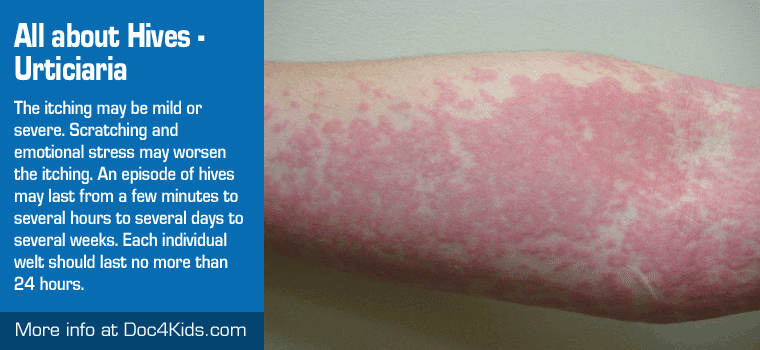Children and Hives (URTICARIA)
Urticaria is another term for “hives.” The condition affects approximately 20% of the population at one time or another. An episode of hives can start as itching, followed by swollen, red welts. The itching may be mild or severe. Scratching and emotional stress may worsen the itching. An episode of hives may last from a few minutes to several hours to several days to several weeks. Each individual welt should last no more than 24 hours.
Acute urticaria is generally due to certain foods and additives, medications, insect stings, and infections. Foods such as eggs, nuts and shellfish are common causes of urticaria. Medications such as aspirin and antibiotics (especially penicillin and sulfa) also are common causes of hives. Infections causing hives include the common cold, strep throat, infectious mononucleosis and certain viruses. In most of these cases, when the reason for hives is removed or avoided, the hives resolve. In many cases, the cause of chronic hives cannot be identified despite detailed testing. In this instance the condition is called idiopathic urticaria. In approximately 50% of cases of idiopathic urticaria, the immune system is causing the release of chemicals such as histamine. In most cases of chronic urticaria, the hives will gradually disappear over time. Physical urticaria is due to one or more “physical” causes. The most common reason for long-lasting urticaria is dermographism. These hives appear within a few minutes of scratching along an area of skin. Most often, the rash is linear, following the path taken by the act of scratching. Delayed pressure urticaria is swelling that appears on areas of constant pressure such as belts and constricting clothing such as sock bands. Cholinergic urticaria is due to an increase in body temperature with sweating, exercise, hot showers, and/or anxiety. Sun-induce durticaria may occur within a few minutes after exposure to the sun. Certain types of chronic hives are more painful than itchy. The hives may go away leaving a bruise on the skin, and individual hives may last more than 24 hours. In such cases, the cause may be inflammation of the blood vessels.
In some cases, the cause is obvious -a person eats peanuts or shrimp, and then develops hives within a short time. Because there are so many possible causes for urticaria, other cases require determined detective work on the part of the patient and physician. In some cases, the cause cannot be identified. A single episode of uncomplicated urticaria does not usually need extensive testing. An episode of hives complicated by swelling or trouble breathing requires immediate evaluation in the emergency room. For uncomplicated urticaria, we will evaluate your child for possible causes. If allergy is suspected, a diary of foods eaten within a few hours before the hives started may be extremely helpful.
Chronic urticaria may have to be evaluated by an allergist-immunologist. The specialist will take a detailed history about your medical history, your family’s medical history, your work and home environment, and medication you’re taking. ln some cases, you may need x-rays and/or tests to analyze blood and urine. Allergy skin testing may provide useful information in some cases. Rarely, if food allergies are suspected skin testing, elimination diet, and/or oral food challenges may be required. The specific cause of urticaria can be identified in approximately 20% of cases. Ongoing research will identify more causes and more effective treatments.
In most instances, urticaria will improve with medications such as antihistamines because they are effective with minimal side effects. Urticaria may require temporary treatment with prednisone or a similar corticosteroid medication. If a causative factor can be identified, the best treatment is to avoid or eliminate that factor. For example, if a problem with a specific food is strongly suspected, then that food should be eliminated from your diet. This will require careful reading of packaged food labels and careful questioning about ingredients in restaurant meals. Persons with physical urticaria should try to avoid exposure to that physical factor, if possible. Patients with solar urticaria should wear protective clothing and apply a sunblock when outdoors. Loose-fitting clothing will help relieve pressure urticaria. For people with dermographism, avoiding harsh soaps and frequent bathing will reduce the problem of dry skin, which can cause itching and scratching that can aggravate this condition.
If you have any more questions, we will be happy to answer them.

